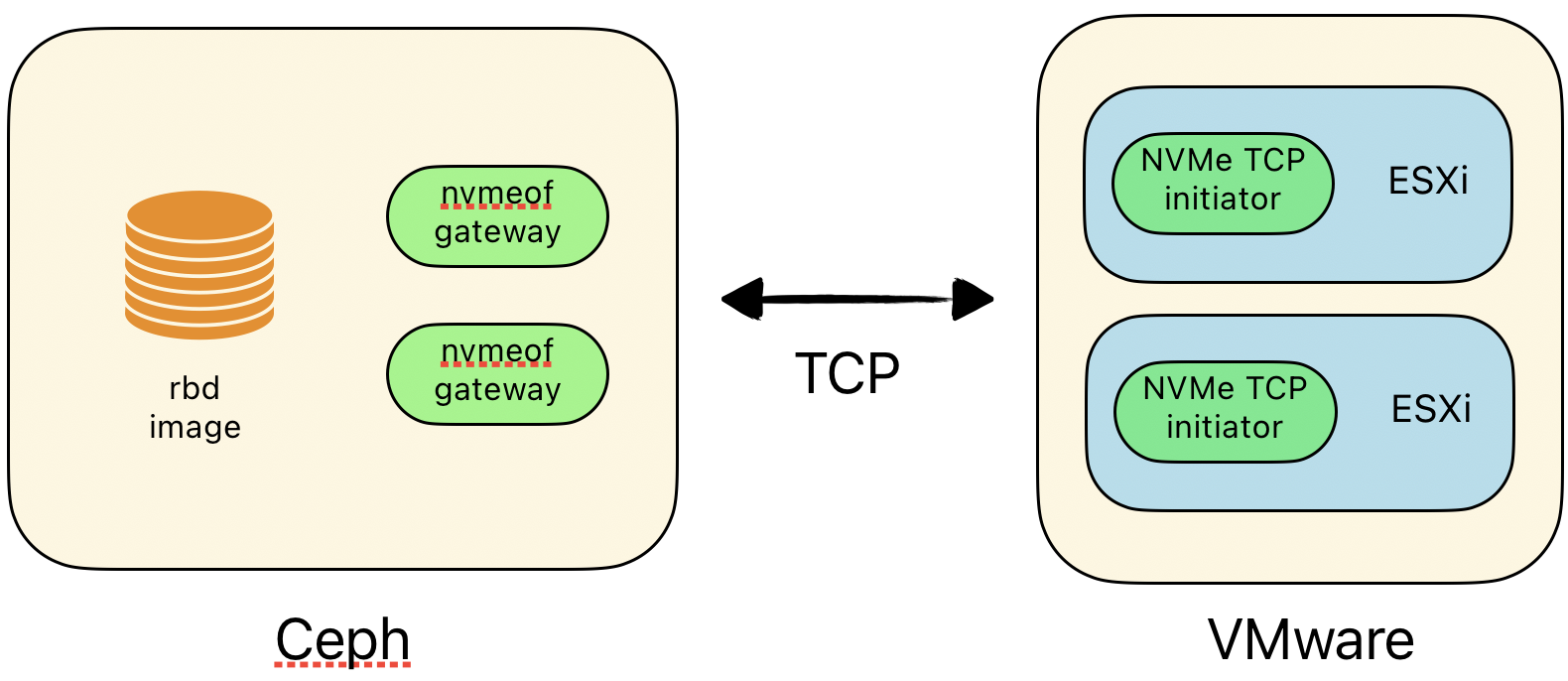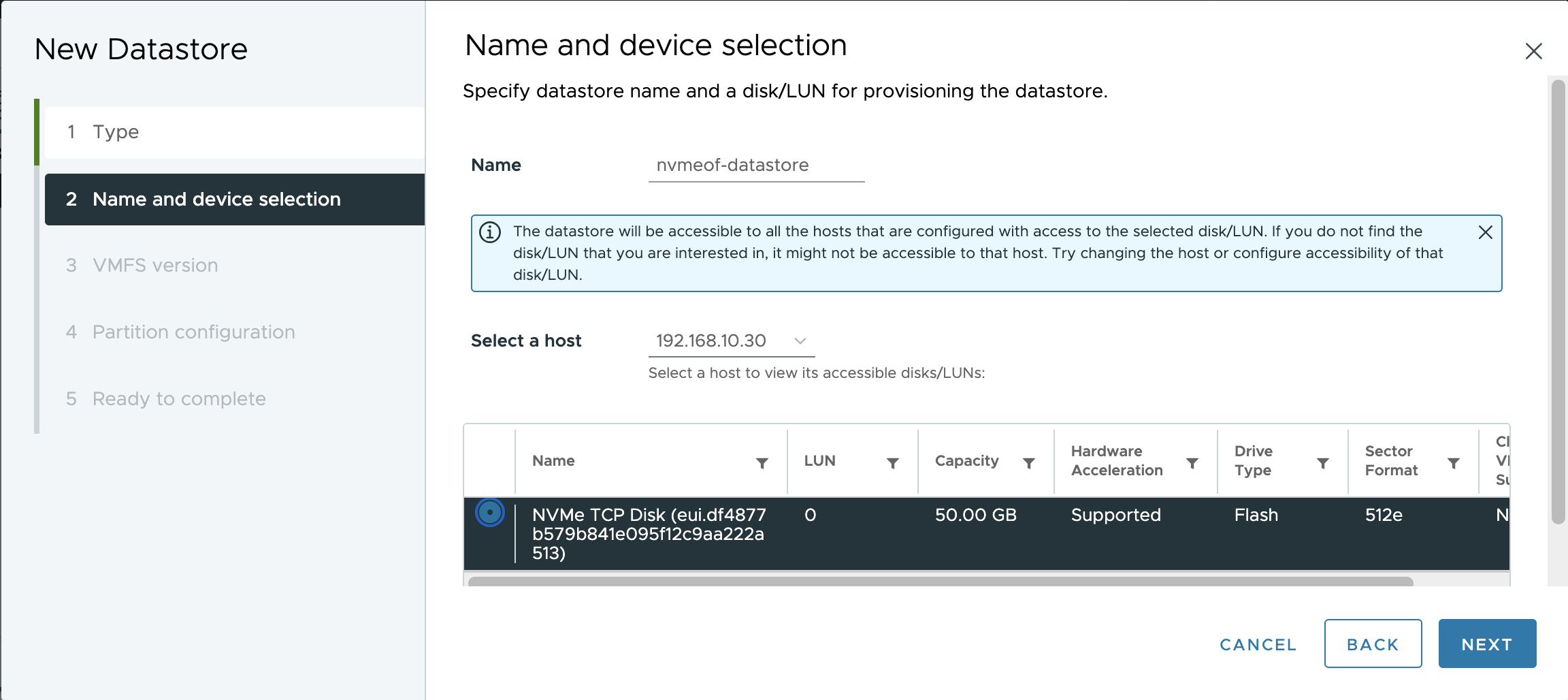A quick test of NVMe over Fabrics (NVMe/TCP) and VMware...
(Tested on Ceph Reef)

Create a RBD volume
# Create a pool "nvmeof_pool01" and a rbd image inside :
ceph osd pool create nvmeof_pool01
rbd pool init nvmeof_pool01
rbd -p nvmeof_pool01 create nvme_image --size 50G
# Deploy nvmeof instance (version 1.0.0)
ceph config set mgr mgr/cephadm/container_image_nvmeof quay.io/ceph/nvmeof:1.0.0
ceph orch apply nvmeof nvmeof_pool01 --placement="ceph01"
Configure NVME Subsystem
# Create an alias to simplify the following commands
# I use the same version of nvmeof-cli:1.0.0, 192.168.10.11 is the host ceph01
# I run those commands directly on ceph host but it could be on any other with podman installed
alias nvmeof-cli='podman run -it quay.io/ceph/nvmeof-cli:1.0.0 --server-address 192.168.10.11 --server-port 5500'
# Create the subsystem, the namespace corresponding the rbd image, and the listener
nvmeof-cli subsystem add --subsystem nqn.2016-06.io.spdk:ceph
nvmeof-cli namespace add --subsystem nqn.2016-06.io.spdk:ceph --rbd-pool nvmeof_pool01 --rbd-image nvme_image
nvmeof-cli listener add --subsystem nqn.2016-06.io.spdk:ceph --gateway-name client.nvmeof.nvmeof_pool01.ceph01.htrgqe --traddr 192.168.10.11 --trsvcid 4420
# Allow all clients (to allow specific esxi clients, retreive NQN address with "esxcli nvme info get")
nvmeof-cli host add --subsystem nqn.2016-06.io.spdk:ceph --host "*"
# List all subsystems
nvmeof-cli subsystem list
╒═══════════╤════════════════════════════╤════════════╤═══════════════════╤══════════════════════╤══════════════════╤═════════════╕
│ Subtype │ NQN │ HA State │ Serial Number │ Model Number │ Controller IDs │ Namespace │
│ │ │ │ │ │ │ Count │
╞═══════════╪════════════════════════════╪════════════╪═══════════════════╪══════════════════════╪══════════════════╪═════════════╡
│ NVMe │ nqn.2016-06.io.spdk:ceph │ disabled │ SPDK4675192209286 │ SPDK bdev Controller │ 1-65519 │ 1 │
╘═══════════╧════════════════════════════╧════════════╧═══════════════════╧══════════════════════╧══════════════════╧═════════════╛
# List namespace
nvmeof-cli namespace list --subsystem nqn.2016-06.io.spdk:ceph
╒════════╤════════════════════════╤═══════════════╤════════════╤═════════╤═════════╤═════════════════════╤═════════════╤═══════════╤═══════════╤════════════╤═════════════╕
│ NSID │ Bdev │ RBD │ RBD │ Image │ Block │ UUID │ Load │ R/W IOs │ R/W MBs │ Read MBs │ Write MBs │
│ │ Name │ Pool │ Image │ Size │ Size │ │ Balancing │ per │ per │ per │ per │
│ │ │ │ │ │ │ │ Group │ second │ second │ second │ second │
╞════════╪════════════════════════╪═══════════════╪════════════╪═════════╪═════════╪═════════════════════╪═════════════╪═══════════╪═══════════╪════════════╪═════════════╡
│ 1 │ bdev_df4877b5-79b8- │ nvmeof_pool01 │ nvme_image │ 50 GiB │ 512 B │ df4877b5-79b8-41e0- │ <n/a> │ unlimited │ unlimited │ unlimited │ unlimited │
│ │ 41e0-95f1-2c9aa222a513 │ │ │ │ │ 95f1-2c9aa222a513 │ │ │ │ │ │
╘════════╧════════════════════════╧═══════════════╧════════════╧═════════╧═════════╧═════════════════════╧═════════════╧═══════════╧═══════════╧════════════╧═════════════╛
# List hosts allowed
nvmeof-cli host list --subsystem nqn.2016-06.io.spdk:ceph
╒════════════╕
│ Host NQN │
╞════════════╡
│ Any host │
╘════════════╛
Configure NVME on ESXi
In this case I use a single network. A dedicated and redundant network with multiple initiators would be better...
This is done on all ESXi hosts :
[root@esxi01:~] esxcli nvme fabrics enable --protocol TCP --device vmnic0
[root@esxi01:~] esxcli network ip interface tag add --interface-name vmk0 --tagname NVMeTCP
Test discovery :
[root@esxi01:~] esxcli nvme fabrics discover -a vmhba65 -i 192.168.10.11 -p 8009
Transport Type Address Family Subsystem Type Controller ID Admin Queue Max Size Transport Address Transport Service ID Subsystem NQN Connected
-------------- -------------- -------------- ------------- -------------------- ----------------- -------------------- -------------------------- ---------
TCP IPv4 NVM 65535 128 192.168.10.11 4420 nqn.2016-06.io.spdk:ceph true
Connect and list namespaces :
[root@esxi01:~] esxcli nvme fabrics connect -a vmhba65 -i 192.168.10.11 -p 4420 -s nqn.2016-06.io.spdk:ceph
# List namespace
[root@esxi01:~] esxcli nvme namespace list
Name Controller Number Namespace ID Block Size Capacity in MB
------------------------------------ ----------------- ------------ ---------- --------------
eui.df4877b579b841e095f12c9aa222a513 256 1 512 51200
# List devices
[root@esxi01:~] esxcli storage hpp device list
eui.df4877b579b841e095f12c9aa222a513
Device Display Name: NVMe TCP Disk (eui.df4877b579b841e095f12c9aa222a513)
Path Selection Scheme: LB-RR
Path Selection Scheme Config: {iops=1000,bytes=10485760;}
Current Path: vmhba65:C0:T0:L0
Working Path Set: vmhba65:C0:T0:L0
Is SSD: true
Is Local: false
Paths: vmhba65:C0:T0:L0
Use ANO: false
Add the datastore from VSphere client :


This promises interesting things...
References :
Ceph NVMEOF Github : https://github.com/ceph/ceph-nvmeof
IBM Ceph Docs NVME-oF Tech Preview : https://www.ibm.com/docs/.../devices-ceph-nvme-gateway-technology-preview
RedHat Doc : Configuring NVMe over fabrics using NVMe/TCP https://access.redhat.com/documentation/.../configuring-nvme-over-fabrics...
Red Hat Ceph Storage: A use case study into ESXi host attach over NVMeTCP : https://community.ibm.com/.../red-hat-ceph-storage-esxi-nvmetcp
VMWare : Configuring NVMe over TCP on ESXi : https://docs.vmware.com/...
ESXI nvme commands : https://vdc-repo.vmware.com/.../esxcli_nvme.html
NVM Express - TCP Transport Specification : hhttps://nvmexpress.org/.../NVM-Express-TCP-Transport-Specification-1.0d-2023.12.27-Ratified.pdf